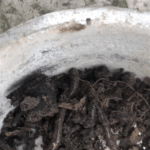When we moved to our home in 2010, we immediately began changing the landscaping. The former owner had mowed nearly our entire two acres. It was clipped, manicured, and lacking in diversity. The soil was sand, rock hard, or dense clay. From this sterile, unnatural yard we created a wondrous landscape rich in plant and animal life.
Over the years we removed exotic ornamental trees and replaced the mowed lawn with native prairie. Now, 11 years later, our yard has transformed into more natural landscapes filled with colorful and fascinating wildlife and plants.
In the early years, one thing puzzled us. No earthworms. If we wanted some for bait, we couldn’t find a single one. As the years moved forward, we began seeing a few worms, and then an abundance as they emerged after a light rain. What made the difference?
The Worm Dilemma
Worms are a dilemma for anyone wishing to favor native species. Common worm species are not native. Transported to the New World during early settlement days, they spread like crazy. Gardeners and farmers love worms for their diligent work softening, fertilizing, and aerating the soil. They are great for gardens but cause ecological damage in forests that evolved without them.
Mostly we like worms. They’re an indicator of soil fertility and health and make our gardens more productive. But, why didn’t we have many in the early years of our ownership?
We suspect the former owner did more than mow. He doused the land with artificial fertilizer and pesticides and suppressed plant diversity. Both made life difficult for worms and other creatures.
It took a few years of composting and diversifying plant species but gradually we saw encouraging signs. More and different beneficial insects came to find dinner and a home in our yard. Worms returned with gusto.
We don’t manage our yard to be completely organic. When we spot a poison ivy sprig our small squirt bottle of herbicide takes care of it. Neither of us wants the awful cases of rash the plant caused us in years past. But, that’s about it. We use no insecticides and, except for the poison ivy killer, no herbicide.
Asian Jumping Worms

Asian Jumping Worms eat the leaf litter in forests that hold and break down into soil.
A few falls ago we brushed aside the garden mulch and were greeted by a few worms thrashing around at whirlwind speed. They were Asian jumping worms. New to Iowa they’ve been in many Eastern states for years. We easily identified them by their fast movement, white clitellum (the band around them), and their size. They’re just a bit smaller than a nightcrawler. These worms damage forests by eating the leaf layer that nurtures many native species and prevents erosion.
Our chickens dined on the Asian jumpers we tossed into their run, but we’re sure we’ll find more.

